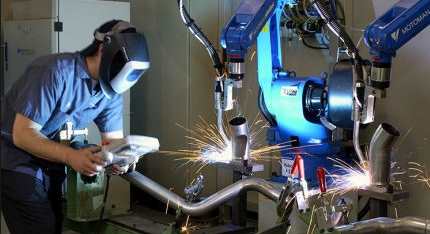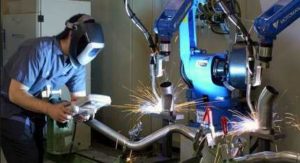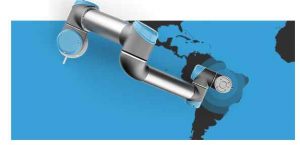The Future Manufacturing: Robotics in CNC machining
Many industries are automating their production processes to gain and maintain a competitive advantage. Robotics and CNC are now trending as a united front in the machining industry, whether in small-scale shops, or large manufacturing spaces. Robots is developing to replace traditional machines to cut, grind, and mill materials efficiently in production processes.
Benefits of Applying Robotics in manufacturing:

Many manufacturing companies are slowly integrating robots to streamline the production processes of CNC machining. The results are:
Higher Productivity
Robots can mill, grind, and cut materials in a factory to produce twice what industrial machining and other traditional approaches do.
Robots can function for hours in a factory without getting tired or demanding breaks in between tasks. Manufacturers can load and offload products effortlessly, thus saving time. Little time is also required for changeovers, hence companies can cater to their customers’ needs economically.
Each machine has to be customized to meet specific manufacturing needs. Therefore, integrating CNC machining to make these robots includes specialized features for each robot. In turn, the robots automatically increase uptime levels and overall throughput while maintaining budget limits during production.
Higher Accuracy
Robots have to be high-performing to carry out specific manufacturing tasks, i.e., packaging solutions, handling materials, and assembling final products. Robotics more using programming to manufacturing, thus, it decrease the effect of human, which is ideal to upgrade precision CNC machining services.
Multi-tasking Capabilities
Unlike human beings, robots can tirelessly service multiple machine parts. Ideally, custom CNC machining includes special features to program a robot to simultaneously load two machines during production. The robot also adapts to a new operation fast compared to human beings. The latter require training and proper guidelines to transition between procedures.
Great Surface Finish Saves Money
If you are looking for technology that achieves an excellent surface roughness, you might want to try a CNC machine. It creates great interacting parts for robots to reduce friction on the surfaces. Consequently, you’ll require less robot maintenance practices for your production equipment; thus saving on extra expenses.
Higher Insourcing Rate
Many at times, manufacturers get complex job requests to create products with different component specifications. That can be a challenge, but with CNC machining, you can implement an automated robotic system with special features. You’ll only need to reset the system and tooling to carry out specific tasks back in house. You can also carry out multiple tasks simultaneously, which increases efficiency and production rates.
The Application of Robotics in CNC machining
Robotic Arm
Robotic arms operate like the human arm to move objects. They are used in CNC machines and devices that handle, pick, and place materials in factories. On the other hand, manufacturers require high-strength equipment to move heavy materials. Such equipment is made with durable materials like steel, aluminum, and some plastics. CNC machining is useful at this point because of its compatibility with most of those materials. The technology can also fabricate plastic components for robotic arms without compromising their structural functionality. In essence, processes like 3D printing cannot achieve such integrity.
End Effectors
End effectors are at the functional end of the robotic arm to enable the machine to perform different tasks. Effectors can be grabbers, suction pumps, or grippers to interact with different objects. Basically, CNC machining fabricates these parts to give them a great surface finish. The technology also creates surfaces with different roughnessess depending on the function. For instance, a Ra 0.8μm would create an excellent finish.
Sensors and Controllers
The sensor receives information from the robot’s surroundings and sends it back to the controller. The main detail or components in sensors and controllers is printed circuit boards (PCB). They make up automation machines and robots. In essence, the process of manufacturing PCB mainly entails chemical etching, which has a few challenges. Ferritic Chloride used in the process causes severe skin irritation. It also increases iron levels in the body to excess amounts. Moreover, the chemical requires extensive disposal procedures, which are quite expensive. CNC machining is a great alternative to eliminate these challenges.
Fixtures and Custom Jigs
These parts hold parts while robot arms work on them. As the name suggests, custom jigs and fixtures are specially made (customized) to help in robotic operations. CNC machining comes in handy to cost-effectively fabricate these custom parts.
Materials
The materials used to create robotic parts in CNC machining determine the efficiency of the assembled robots. The materials include:
Steel
Steel is dense but hard enough to create heavy-duty robots. The material can withstand high impact i.e., heavy tasks in manufacturing companies. The stiffness of the material is also ideal for making parts for large robots.
Aluminum
Aluminum is easy to cut through with a CNC machine and is corrosion-resistant. The metal is also strong and has good weight properties for making parts for small and medium robots. However, Aluminum is not as strong as steel to create parts for heavy lifting. Such robots are conveniently lightweight, therefore carry out lighter tasks in a manufacturing company.
Acrylonitrile Butadiene Styrene (ABS)
ABS is a machinable and threadable plastic for making smaller robots. Other properties include rigidity and a yield strength of about 5000 psi. Compared to steel and aluminum, ABS is less dense with a higher impact resistance. As such, it creates robot parts for machines that continually perform multiple tasks.
Conclusion
Robots are exceptionally efficient and simple to operate. Besides productivity, they are economically feasible in the manufacturing industry. Increased demand has pushed the need for CNC integration in the robotics industry. Many companies widely accept CNC machining as the ideal process to automate robotic parts, i.e., sensors and controllers, end effectors, robotic arms, and jigs and fixtures.
Now that you understand the relevance of CNC machining in robotics automation, you’d agree that it can fabricate and customize various parts to increase productivity. The process will only be excellent as long as you work with professional CNC machinists and engineers to get custom robotic parts for your equipment.






